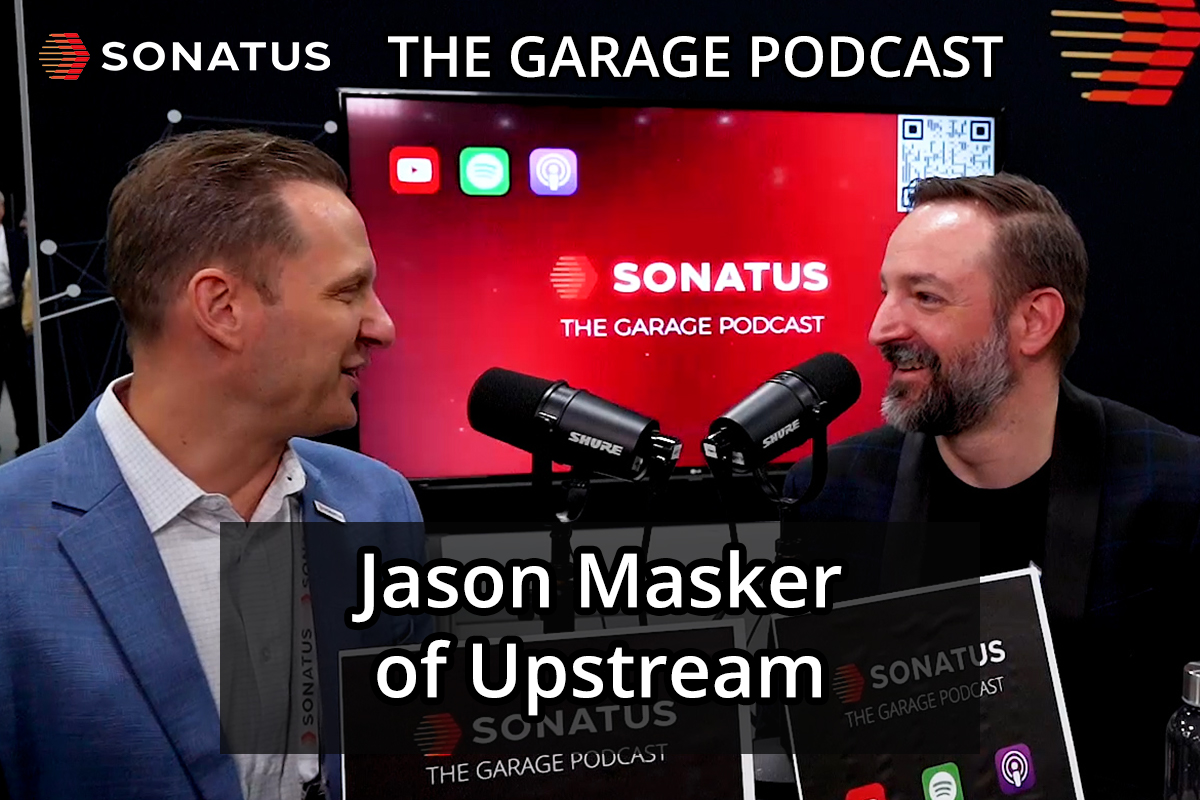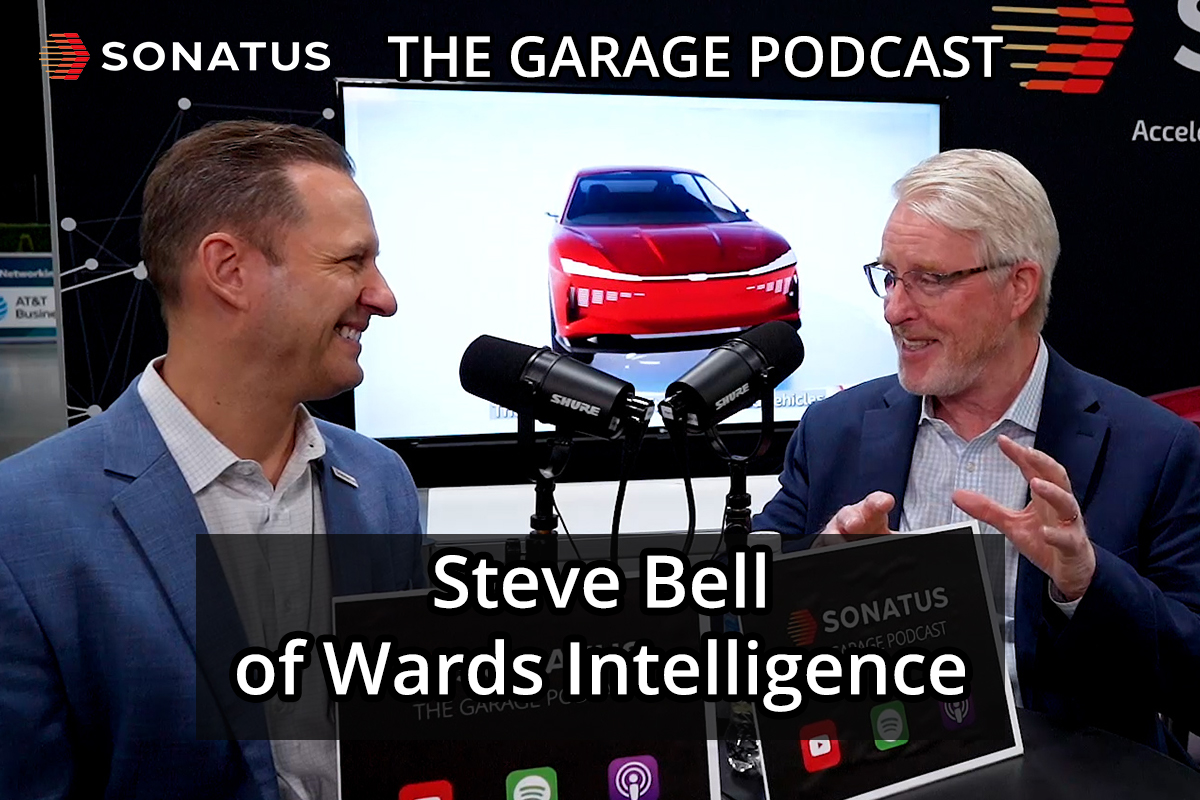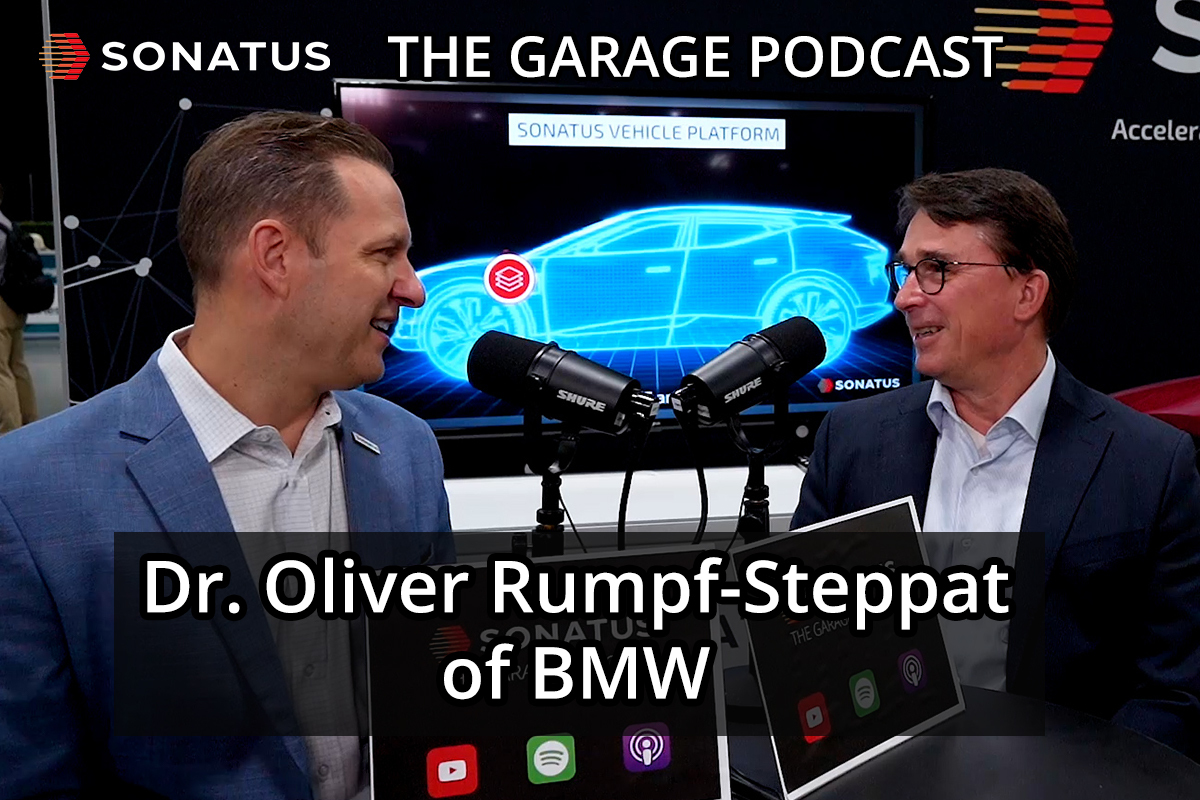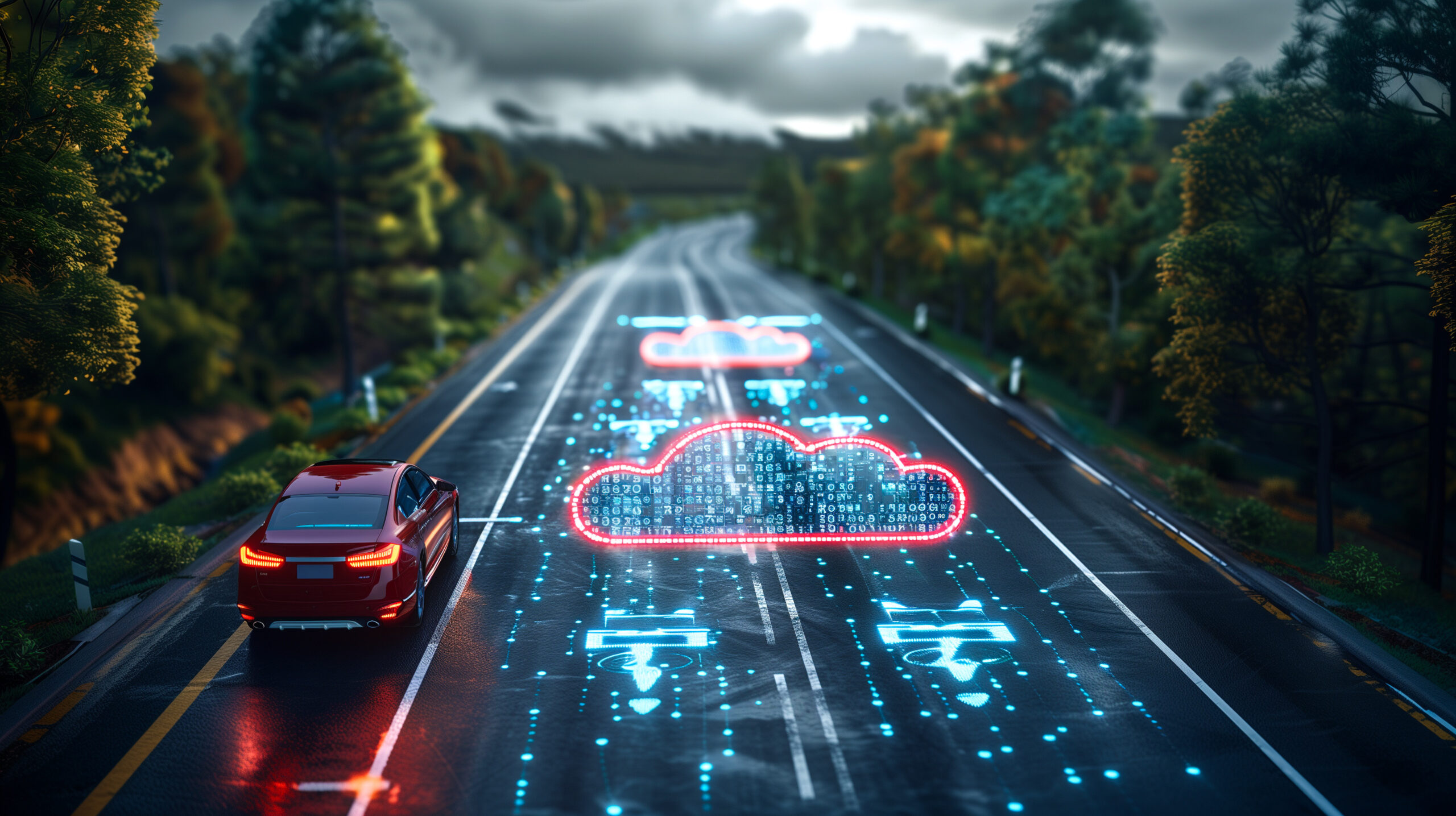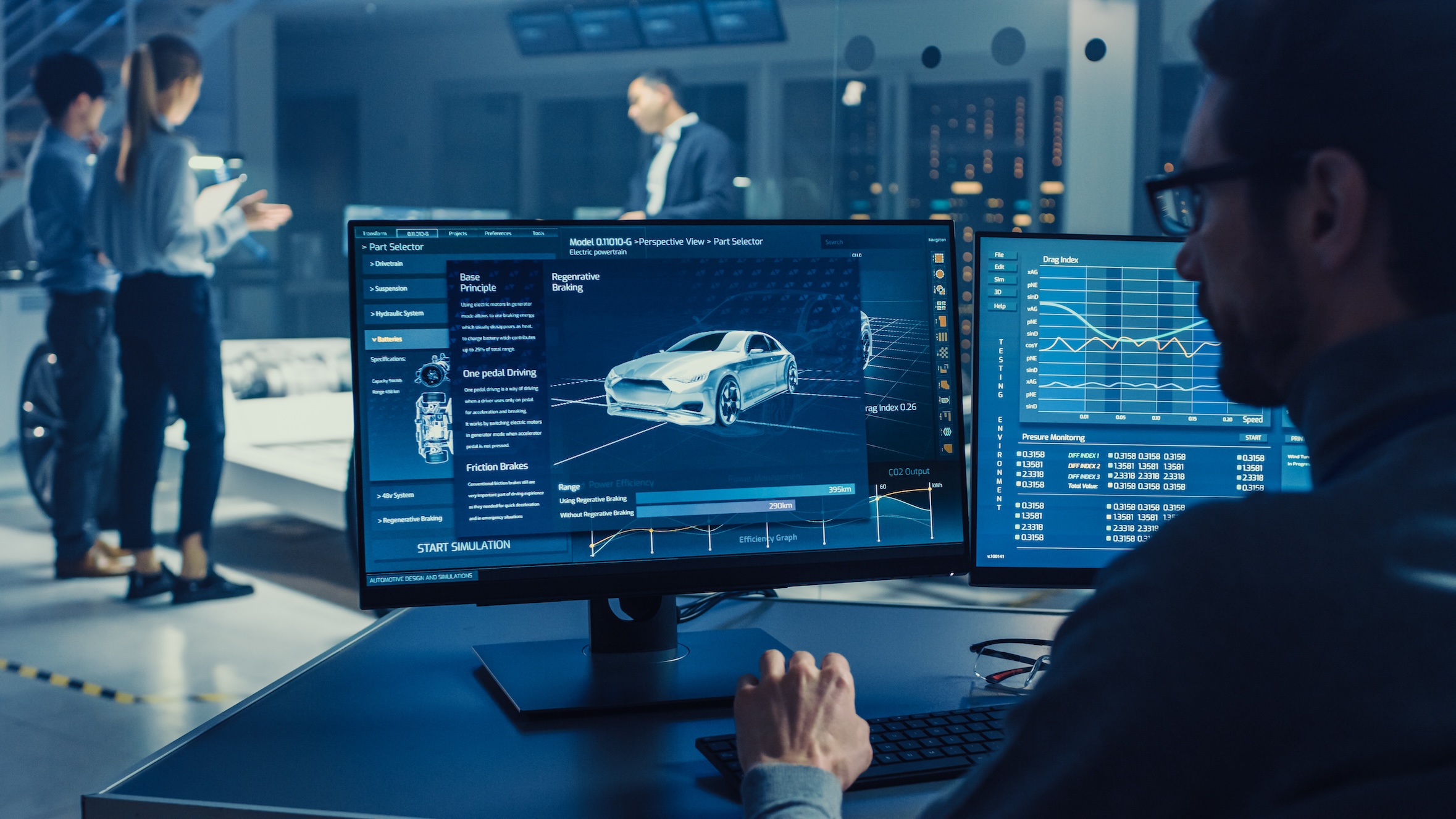Overview
JOHN: Today in The Garage, we’re live from Auto Tech Detroit, where we’ll talk connected cars with AT&T. Let’s go.
JOHN: Welcome to The Garage. I’m John Heinlein, Chief Marketing Officer from Sonatus. We’re recording live from Auto Tech Detroit 2024. Today’s guest is Matt Harden. Matt is Assistant Vice President for business development for connected cars for AT&T. Matt, welcome to The Garage.
MATT: John, thanks for having me. It’s great to be here.
Meet Matt Harden
JOHN: We always like to start by getting to know our guests. Tell us a little bit about you and your background.
MATT: So after college, I had to serve back time to the Navy, and I was a Navy pilot, which, I did that for nine years. And after nine years of serving our country, elected to leave active duty. And I started my career at AT&T. I still actually do reserve duty. I’ve been doing it now in the reserves for 16, so a total of 25 years with the Navy.
JOHN: Wow.
MATT: But, it’s been quite the contrast of, you know, being able to work at AT&T, work with connected cars, to put the uniform on, you know, one weekend a month, two weeks of active duty time every year.
JOHN: Wow.
MATT: And, you know, get to see both worlds.
JOHN: Well, thanks for your service. We always ask a fun fact about you and you kind of went right into that. So you were a pilot in Afghanistan, I think you said, and other places?
MATT: Yes. I flew…I got my wings right before 911 and then did a couple of deployments overseas in the early days of what was going on in Operation Enduring Freedom in Afghanistan. Spent time all through Southeast Asia, and then back in Iraq and Afghanistan with Operation Iraqi Freedom. So that was when I was on active duty flying. I flew P-3 Orions. And then, as a reservist, I was recalled to active duty in 2017 for a year, where I was actually in charge of a drone operation in Afghanistan where I was nine months in boots-on-ground Afghanistan, working with the Special Forces over there, in charge of a 60-man drone operation.
JOHN: Well, that’s incredible. What a great story. Well, thank you for your service.
MATT: Thank you.
JOHN: And, I always like to say a fun fact about me to link to our guest. My dad was in the Navy many years ago.
MATT: Nice.
JOHN: Not a pilot, he was actually on-ship. But he’s very proud of that background. And so I had to think about…I thought about that immediately when you mentioned that
MATT: That’s great. We bleed blue and gold together. So I love that.
Matt’s role at AT&T
JOHN: So now tell us about your role at AT&T. AT&T is a huge sponsor of Auto Tech. And connected cars is an important area for AT&T. Tell us about your your focus.
MATT: Yeah. So we started the Internet of Things solutions group back in, around the 2014-15 timeframe, right when IoT was really becoming a buzzword, not only in automotive, but, you know, across the industry. You know, we’ve gone through a couple of transformations within AT&T through the years. We kind of split us up during the COVID years and kind of took different parts of the organization and moved them into functional areas of AT&T. We always stay within a sales organization. In the ‘22 time frame, you know, the company looked at the growth we continued to have not only in connected car, but across IoT and said, you know what, this is really a great area to be in. We’ve done a good job growing our leadership in this space. What if we were to kind of put the pieces back together, put a real strategic focus around it? And so, in 2023, they formed us as Connect Solutions. My function is sales and business development. So I have a primary function on connected car. Only working with the auto OEMs, ensuring that, you know, when they’re making connectivity choices, hopefully they’re choosing AT&T. And then I’ve got a peer of mine that does the rest of IoT. So basically anything that’s not a car, IoT. But that’s been our focus. So AT&T, in this space, has been a leader in the United States and maintains that leadership position today.
Data into vehicles
JOHN: That’s fantastic. When you think about looking it, looking at it from an auto lens, what are some of the most important areas that you’re providing service into vehicles. You talked in your keynote earlier– you were talking about over-the-air updates and so on. I’d love to get a sense of, what are the… you see are the most important areas?
MATT: Yeah. So for us, we want to enable the OEM to be able to provide the best customer experience. We want to not be a detriment to a great customer experience. At the end of the day, customers have a choice when they are purchasing a vehicle. Vehicle prices are not going down, they are only going up if you’ve purchased one recently. But they’re also putting a lot of really good tech in those vehicles that go along with that. So we want our connectivity to enhance those solutions, right? And so everything that we do is focused around not just being a pipe to the vehicle that can provide the safety, security diagnostics of that vehicle that are really important to the OEM. And then maybe deliver that, you know, to a customer via a branded application. We have head unit applications. We work with a number of third parties that want to bring sponsored data into the vehicle. And then, obviously the Wi-Fi hotspot as well. But as we look at 5G, 5G standalone and edge cloud compute–- and I talked a little bit about it in my keynote— We’re looking to enhance that experience. Give the OEM more visibility, more control, you know, of the network and what the network can do for that vehicle. It is becoming a critical component. When you start talking software updates, there’s going to be regular software updates that go out like an iPhone release. There’s going to be mission-critical updates that need to go out that can prevent recalls and safety incidents. And so we’re trying to figure out how we can ensure all of that can happen, you know, at all times for these OEMs.
Differentiating data services
JOHN: While at first glance, people might feel that the network connection to a vehicle is generic, the reality is, with the new 5G networks, you have the ability to differentiate your services compared to classic networks. What are some of the ways that you’re differentiating your services?
MATT: Yeah, so we look at 5G. We’re doing a lot to develop “advanced network services” that we’re calling them. And we’ve got a product that we’re really wrapping, a few different things around called Network IQ. And one of those components is our AT&T mobile threat and anomaly detection. And I talked about it in the keynote today. So that one’s actually available on LTE today. Right? So that’s using AI machine learning to take a look at all the different access points into a vehicle. And looking across, you know, everything that’s occurring and identifying any anomalies, right? And so it’s important when you start looking at software loads on vehicles, APN mismatches, you know, you can identify traffic down to application level, right? So it does these really great things that a lot of the OEMs are starting to ask for. We have to figure out collectively how we enable the software updates to occur. Firmware, software, you know, whether it’s happening on a charger, at a home on a Wi-Fi.
JOHN: Sure.
MATT: The cellular network, they all need to be in play. We’ve got to look at the 24 hour, seven days a week, 365, but there’s something that we collectively need to go figure out and how we can deliver this seamlessly and really not make it a concern, because today it is a huge, I think, stress and concern for a lot of OEMs.
JOHN: That’s right. My existing vehicle, I won’t name the brand, one of my existing vehicles… It’s very fussy about getting its updates. You got to drive into the driveway and connect on Wi-Fi. But the reality is there are certain mission-critical updates that have to happen sooner. One of the products that Sonatus launched recently is our Sonatus Updater product, which is, we believe, the industry-leading solution for vehicle OTA because it identifies, as you said, some of the unique requirements of vehicle OTA, which might be different than, you know, cell phones or other devices that get updates. Vehicles, sometimes it can be mission-critical. But also they’re not all created equal. And how do we make sure we’re doing the right updates at the right time? So I think that’s really important.
The shift to 5G
JOHN: You know, another benefit from 5G is it’s a very dynamic network. You can provide, for example, extremely low latency and so on. Are you seeing there’s much interest in that so far?
MATT: And so anytime you have a new technology, a new G that’s introduced, there’s a huge barrier to entry in terms of cost, right? And so we haven’t seen the 5G adoption as quickly as what we had hoped and expected at this point. But the low latent applications, it’s funny, you know, we’re still working with cloud providers, we’re still working with the OEMs, we’re still working internally. Everyone’s really putting their heads together. There’s some basic ones that exist today in terms of use cases. We haven’t really landed on that killer app yet, right, that says, this is why I need an ultra-reliable, ultra-low latency network. We all believe there’s going to be that killer app that’s there. We just haven’t landed on it yet.
V2X taking time
JOHN: Well, you mentioned in your keynote remarks earlier about, V2X, you know, vehicle to infrastructure, vehicle to vehicle. And, you come into– which I think it’s exactly right– that there was a kind of an early excitement phase a few years back where there was a lot of work on that. It slowed a little bit. I think partially because of regulatory complexity in my… Where I live, if I drive five minutes, I can go through three cities in five minutes, because of the very high-density area. And so dealing with the regulation there is a bit more complicated. But I do believe that V2X is a killer app. It’s not going to be here tomorrow, but I think it will really help congestion, safety, you know, awareness of how the vehicles are moving through a city. That can be helpful.
MATT: Yeah. No, you’re absolutely right. And, you know, we do feel very strongly about cellular V2X, connected infrastructure, all those things. The regulatory component of that I think is a big hurdle that we still haven’t quite figured out. A lot of cities, a lot of municipalities want to do this. They see the value of doing this. They’re trying to figure out how they’re going to pay for this. And so it’s going to take government oversight. It’s going to take public/private partnership. But we’re working with a number of local cities and municipalities to go test out this technology. The beautiful thing is it works.
JOHN: Yeah.
MATT: You know, it does. And there’s some great companies that are doing some really innovative and exciting things in this space. It’s just, how do you take a small section of a city and now blow that out to a full city?
JOHN: Yeah.
MATT: And then push that out on the roadways and all of that. So I think we’ll see, you know, we’re talking about autonomous a lot right? Around this show, and in the keynote a little bit. I think the autonomous trucks will probably be the guys that get there first because they’ve got long-haul routes. They can, you know, pick up cargo and then move it across a major interstate at times when they’re not that congested. So I think we’ll see that use case start to develop first and then just kind of grow from there.
JOHN: Yeah, I think that’s right. Talking about whether it’s caravanning or highway applications. It’s probably going to be the tip of the spear. Speaking about cities, it feels to me, I mean, government– sometimes people say– government is the enemy. And that may be true sometimes. But when you think about the heterogeneous nature of the way we govern it, you know, federal, state, local level, it seems to me like standards are going to have to come. Yesterday, there was a panel they were talking about just that. And unless we come up with suitable standards that the industry can adopt, it’s going to be a real delay factor. So I’m hoping that sensible, thoughtful, informed, regulation can help to bring some standards that can really propel this forward. It has the potential for safety and sustainability benefits, I think, that could be really useful.
MATT: Yeah. I think if you just keep your focus around the safety component. I talked to Alex today– in my keynote– talked about the number of accidents and deaths that you’re seeing on the road.
JOHN: Which is going up.
MATT: Going up, which is surprising, right?
JOHN: It is.
MATT: So you got that component. You keep it focused on sustainability. I think everybody can put their heads around why this is good. And then hopefully, like you said, you know, cooler heads will prevail and we’ll come out of it with some good regulation.
AT&T at AutoTech Detroit
JOHN: AT&T is a major sponsor of Auto Tech and you have been for several years. What are some of the important things you see at the show, as you’re walking around?
MATT: Yeah. So we’ve, we’ve participated in the show a number of years, you know, obviously we took a break during the COVID era, but we jumped back in, three years ago. We think it’s a great show to be a part of. Anytime you can bring people to, you know, Detroit, the Motor City, kind of middle of the year. You start off the year with CES, which is really become an automotive focus. If you have not been at CES recently, you should go see the West Hall. It’s really impressive what they’re doing out there in terms of automotive. You know, they get MWC from an international perspective. But then there’s this lull. And I’ve talked to a number of analysts around, you know, their perspective of this show and everybody sees the value. So I think Wards and Informa have done an outstanding job of continuing to grow the show. And it draws a lot of people here. And you get great participation across not only the industry but the OEMs. What we’ve seen is kind of what we were talking about. You’ve got a lot of small companies that are really doing some innovative things. A lot of it’s focused around safety. There’s a lot of companies here that really truly want to make a difference and are trying to help make the automotive industry safer as a whole. So it’s fun to walk around. A lot of companies I have never heard of before, but leave with an appreciation for what they do and the technology that they’re driving. And honestly, it’s their passion. You always run into your customers here. I get to run into board members like yourself, which is always great to connect. It’s fun to be here in this ecosystem because there’s so much going on. You know, I was asked a question coming here. Like, do you love what you do? And I said, I honestly do like it’s weird to say that, but I get to be part of an industry that we get to do things that not only are on the road today, but are going to be here two, three, five, ten, 15 years from now and we get to experience them as consumers. Our kids get to drive these vehicles, and it’s all driving towards a better and safer roadway.
JOHN: I mean, you mentioned CES. We have a major presence, Sonatus has a major presence at CES every year. If you’ve not come by, you should check it out. But, we’re proud to be… you know, we’re both on the steering committee, the steering board for Auto Tech. So we’re proud to be here and sponsor every year. And glad to see it. You’re right. There’s a real diversity of vendors here of different types. They also show off a lot of incredible OEMs. They have the Ward’s Best Interiors, which I always like, and user interface. It’s exciting to see how they’re looking to evolve user interface for vehicles.
Conclusion
JOHN: You know, coming back to AT&T, I also want to mention, you know, how important a partnership I think it is between Sonatus… One of the things we focus on is data. And so we see the network in the cloud– by extension that the data goes to– is really important to providers, you know, both for safety as well as adding value to vehicles, improving quality of vehicles and improving services. So that’s why we really wanted to have you on the podcast. And it was great to meet you, and I’m so glad for you spending so much time with us.
MATT: Yeah. You know, it’s interesting. We’re so busy, all of us, you know, trying to just go do the work and drive new business and deliver new solutions that sometimes we kind of just, you know, it’s like two ships passing in the night, right? So we get an opportunity like this a go, wait, there’s a good intersection there in what you’re doing, what we’re doing. Like we need to have these conversations. Let’s get talking, right? And so that’s why I feel it’s important to come to these things and to continue to grow the network and understand what you guys are doing, and then look for ways that we can partner and hopefully continue to make it better.
JOHN: Absolutely. Hey, thank you for coming by and talking with us today.
MATT: Thanks for having me. It’s great to see you.
JOHN: I hope you’re enjoying the episodes of The Garage from Auto Tech Detroit. Stay tuned for more episodes to come in the future weeks. We’ll see you again in another episode soon.
